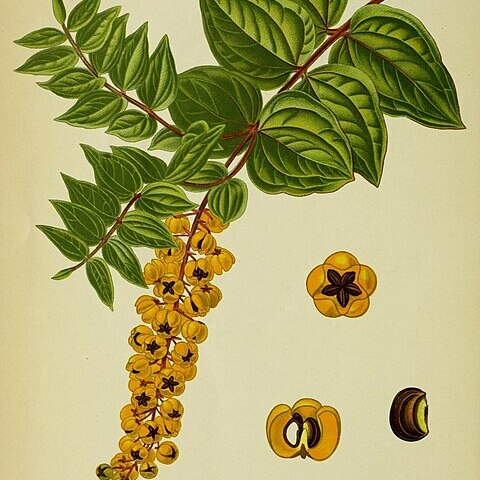Shrubs decumbent, 1.5-2.5 m tall, with horizontally spreading branches; branchlets tetragonous or narrowly 4-winged; young branches purplish red, puberulent or glabrescent; old branches purplish brown, with clearly prominent lenticels; bud scales purplish red, ovate or ovate-triangular, 1-2 mm, membranous, glabrous. Leaves opposite; petiole purple, 2-3 mm, puberulent, inflated into pad at base; leaf blade elliptic or broadly elliptic, 2.5-8 × 1.5-4 cm, papery to thinly leathery, both surfaces glabrous or puberulent on midrib and lateral veins, 3-veined to apex, veins raised abaxially, slightly impressed adaxially, base rounded, margin entire, apex acute. Inflorescences axillary. Male inflorescence 1.5-2.5 cm, densely multiflorous, flowers opening before leaves, rachis glandular puberulent; bracts and bracteoles ovate-orbicular, ca. 2.5 × 2 mm, membranous, translucent, concave, margins fringed denticulate upward; pedicel ca. 1 mm, glabrous; sepals ovate, 1.5-2 × 1-1.5 mm, margins translucent, fringed denticulate; petals ovate, very small, ca. 0.3 mm; filaments linear, ca. 1 mm, elongating in anthesis, 3-3.5 mm, anthers oblong, ca. 2 mm; sterile pistils small. Female inflorescence with flowers opening at same time that leaves appear, 4-6 cm, rachis glandular puberulent; bracts purplish, ca. 4 mm; pedicel 1.5-2.5 mm; sepals same as in male flower; petals small, fleshy; stamens short, filaments ca. 0.5 mm; carpels 5, compressed, auriculate, ca. 0.7 × 0.5 mm, styles ca. 1 mm, stigma purplish red. Fruit red to dark purple or purplish black when mature, subglobose, 4-6 mm in diam. Seeds ovoid-oblong. Fl. Feb-May, fr. May-Aug. 2n = 40.
More
A tree. It grows to 5 m tall. The leaves are almost without stalks. They are opposite. The leaves are 2-10 cm long by 1.5-4 cm wide. They are oval or sword shaped. They have 3 veins. The flowers do not have stalks. They are red. The fruit is black when ripe.

